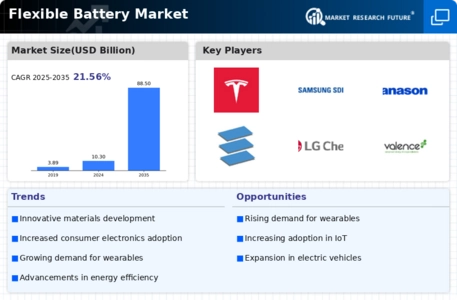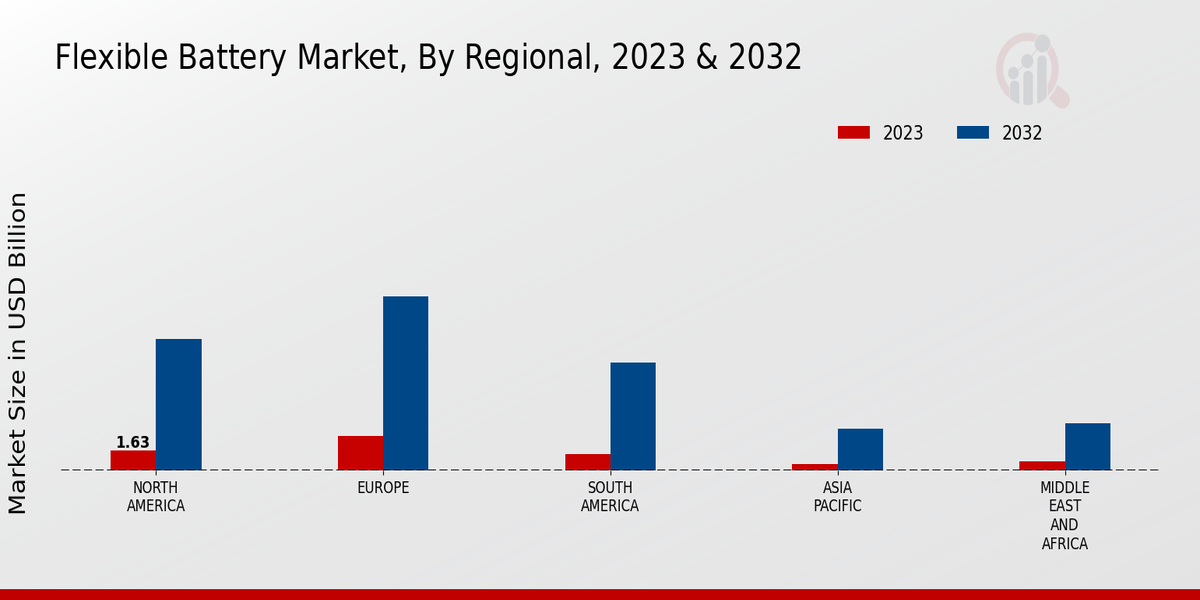Market Growth Projections
The Global Flexible Battery Market Industry is projected to experience substantial growth over the coming years. With a market value of 10.3 USD Billion in 2024, it is expected to reach 88.5 USD Billion by 2035. This growth trajectory indicates a robust compound annual growth rate (CAGR) of 21.56% from 2025 to 2035. Such projections reflect the increasing demand for flexible batteries across various sectors, including consumer electronics, automotive, and renewable energy. The market's expansion is likely to be driven by technological advancements, rising consumer preferences for lightweight solutions, and the growing emphasis on sustainability.
Growing Electric Vehicle Market
The surge in the electric vehicle (EV) market is significantly influencing the Global Flexible Battery Market Industry. As manufacturers strive to produce lighter and more efficient batteries, flexible batteries are emerging as a viable solution. The integration of flexible batteries into EV designs can enhance vehicle performance and range. With the global EV market expected to expand rapidly, the flexible battery segment is likely to see substantial growth. By 2035, the overall flexible battery market could reach 88.5 USD Billion, driven by the automotive industry's shift towards innovative battery technologies.
Increased Focus on Renewable Energy
The global shift towards renewable energy sources is a crucial driver for the Global Flexible Battery Market Industry. As countries aim to reduce their carbon footprints, the demand for efficient energy storage solutions is rising. Flexible batteries offer a promising alternative for storing energy generated from renewable sources such as solar and wind. Their lightweight and adaptable nature makes them suitable for various applications, including grid storage and portable energy systems. This trend is expected to contribute to the market's growth, aligning with global sustainability goals and the increasing need for reliable energy storage.
Emerging Applications in IoT Devices
The proliferation of Internet of Things (IoT) devices is fostering growth in the Global Flexible Battery Market Industry. As IoT technology advances, the need for compact, flexible, and efficient power sources becomes increasingly critical. Flexible batteries are well-suited for powering a wide range of IoT applications, from smart home devices to industrial sensors. This growing demand is anticipated to drive the market forward, as manufacturers seek innovative battery solutions to meet the unique requirements of IoT devices. The flexible battery market is poised for substantial growth as these applications expand globally.
Rising Demand for Wearable Technology
The increasing adoption of wearable technology is a primary driver for the Global Flexible Battery Market Industry. Devices such as smartwatches, fitness trackers, and health monitoring gadgets require lightweight and flexible power sources. The market for wearables is projected to grow significantly, with estimates suggesting that the demand for flexible batteries in this sector could contribute to the overall market reaching 10.3 USD Billion in 2024. As consumers seek more advanced features in wearables, the need for efficient, compact, and flexible batteries becomes paramount, thereby propelling the growth of the flexible battery market.
Advancements in Energy Storage Solutions
Technological innovations in energy storage solutions are transforming the Global Flexible Battery Market Industry. The development of high-capacity, lightweight, and flexible batteries is enabling new applications in various sectors, including consumer electronics and electric vehicles. As energy storage technologies evolve, they are expected to enhance the performance and lifespan of flexible batteries. This trend is likely to drive the market's expansion, with projections indicating a compound annual growth rate (CAGR) of 21.56% from 2025 to 2035. Such advancements not only improve efficiency but also support the growing demand for sustainable energy solutions.
























